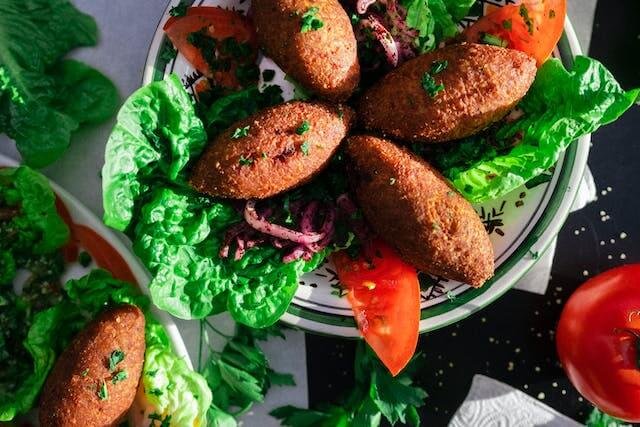Table of Contents
ToggleLebanese Food for Personal Chefs
As personal chefs, our culinary journey takes us around the world, exploring different cuisines and flavors. Today, we are venturing into the heart of the Middle East to explore the rich and vibrant world of Lebanese cuisine. Known for its bold and aromatic spices, fresh ingredients, and mouth-watering dishes, Lebanese food has become a popular choice for many personal chefs.
Lebanese cuisine is heavily influenced by the Mediterranean region, using an abundance of olive oil, herbs, grains, and vegetables in their dishes. The use of fresh herbs such as mint, parsley, and cilantro not only adds flavor but also provides health benefits.
Key Ingredients in Lebanese Cuisine
Lebanese cuisine is characterized by a plethora of fresh ingredients and aromatic spices. Some of the key ingredients include olive oil, chickpeas, tomatoes, tahini, za’atar (a mix of thyme, roasted sesame seeds, sumac, and salt), cumin, cinnamon, allspice, black pepper, white pepper, ground cloves, ground nutmeg, coriander, and various fresh produce.
Olive oil is a staple in Lebanese cooking, being used for everything from frying to dressing salads. Chickpeas are commonly used in dishes such as hummus and falafel, while tomatoes are often found in stews, sauces, and salads. Tahini, made from ground sesame seeds, is an essential ingredient in dishes like hummus and baba ghanoush.
Za’atar is a popular spice blend that adds a unique flavor to many Lebanese dishes. It can also be sprinkled on flatbread or mixed with olive oil for a dip or spread. Cumin, cinnamon, allspice, black pepper, white pepper, ground cloves, and nutmeg add warmth and depth of flavor to dishes like meatballs, kebabs, and stews.
In addition to these spices, fresh herbs play a crucial role in Lebanese cuisine. Mint, parsley, cilantro, and dill are frequently used to add freshness and brightness to dishes. These herbs can be found in salads like tabbouleh or mixed with yogurt for a refreshing dip.
Lebanese cooking also incorporates plenty of vegetarian options, making it a great choice for those following a plant-based diet. Eggplant is often featured in dishes like moussaka and baba ghanoush. Lentils and rice are commonly combined to make mujaddara, a hearty and nutritious dish that is flavored with caramelized onions.
Meat lovers won’t be disappointed either – lamb is the most popular meat in Lebanese cuisine and is used in a variety of dishes such as kebabs, shawarma, and kibbeh. These dishes are often served with flavorful sauces like tahini or toum (garlic sauce) and accompanied by sides like hummus, pita bread, and pickled vegetables.
Aspiring personal chefs need to offer something different than traditional chefs who specialize in one or two kinds of cuisines. I’ve written an extensive article with links to many cuisines for your consideration – World Cuisine for Personal Chefs
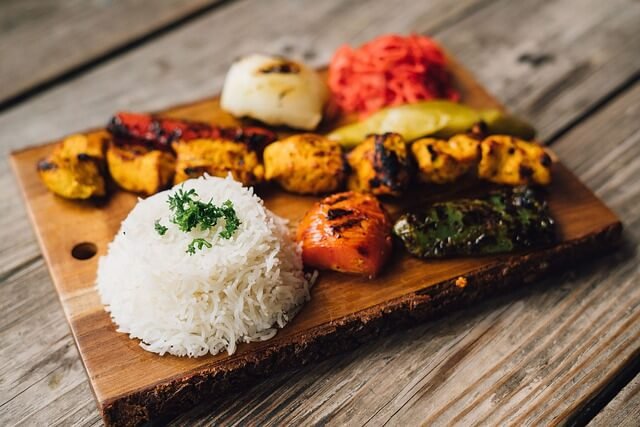
Sourcing Ingredients Locally
While many of these ingredients can be found in local supermarkets, some might require a visit to a specialty Middle Eastern grocery store.
If certain ingredients are not available locally, suitable substitutes can often be found. For instance, you could substitute za’atar with a mix of dried thyme, toasted sesame seeds, and a pinch of salt. Or, instead of pomegranate molasses, try using balsamic vinegar mixed with a little honey.
Traditional Cooking Methods
Lebanese cuisine employs a variety of cooking methods, including grilling (for dishes like kebabs), baking (for dishes like manakish), boiling (for stews), and sautéing. These traditional cooking methods not only create delicious and flavorful dishes, but they also add a unique cultural aspect to the food.
Grilling is a popular method of cooking in Lebanese cuisine, particularly for meats like lamb and chicken. The meats are marinated in a blend of herbs and spices before being cooked over an open flame, giving them a smoky and charred flavor. Grilled vegetables, such as eggplant or zucchini, are also commonly enjoyed in Lebanese cuisine.
Another common cooking method is baking, which is used for savory dishes like manakish (a type of flatbread topped with za’atar spice) and sweet desserts like baklava (layers of phyllo pastry filled with nuts and syrup). Baking adds depth and richness to the flavors of these dishes.
Mezze platters are a staple in Lebanese cuisine, featuring an array of small dishes that are meant to be shared with others. These may include hummus (a dip made from chickpeas), baba ghanoush (a smoky eggplant dip), tabbouleh (a parsley and bulgur wheat salad), and falafel (fried chickpea balls). Mezze platters are a great way to try a variety of flavors and textures in one sitting.
Lebanese cuisine also includes a lot of dairy, particularly yogurt and labneh (a strained yogurt cheese). These are often used as toppings or accompaniments to dishes, providing a cool and creamy contrast to the bold spices. Labneh is also commonly used as a spread for breakfast or as a dip for vegetables.

Dominant Flavors of Lebanese Cuisine
Lebanese cuisine is known for its bold, fresh flavors. It often combines tangy, savory, and sweet elements, creating a depth of flavor that is both complex and balanced. Here are some of the dominant flavors you’ll find in Lebanese cuisine:
Garlic
Garlic is a staple ingredient in Lebanese cooking. It adds a pungent, slightly spicy flavor to dishes and is often used as a base flavor for sauces and marinades.
Olive Oil
Olive oil is another essential ingredient in Lebanese cuisine. It is not only used for cooking but also as a finishing touch on many dishes. The rich, buttery flavor of olive oil adds depth and richness to dishes.
Lemon
Lemon juice or zest is commonly used in Lebanese dishes to add brightness and tanginess. It can be found in everything from salads to marinades and sauces.
Sumac
Sumac is a spice that is used in many Middle Eastern cuisines, including Lebanese. It has a tangy, slightly sour flavor and is often used as a seasoning or garnish for dishes.
Cumin
Cumin is a widely used spice in Lebanese cuisine, adding warmth and depth to dishes. It can be found in everything from meat marinades to vegetable dishes.
Mint
Mint is another popular herb in Lebanese cuisine, adding freshness and brightness to dishes. It is commonly used in salads, dips, and meat dishes.
Parsley
Parsley is an essential herb in Lebanese cooking, often used as a garnish or included in salads and sauces for its fresh, green flavor.
Lamb
Lamb is the most commonly used meat in Lebanese cuisine, often cooked on a spit or grilled and served with various spices and sauces.
Chickpeas
Chickpeas, also known as garbanzo beans, are a staple in Lebanese cuisine. They can be found in dishes such as hummus, falafel, and stews.
Labneh
Labneh is a creamy strained yogurt popular in Lebanon that is often served as a dip or spread on bread.
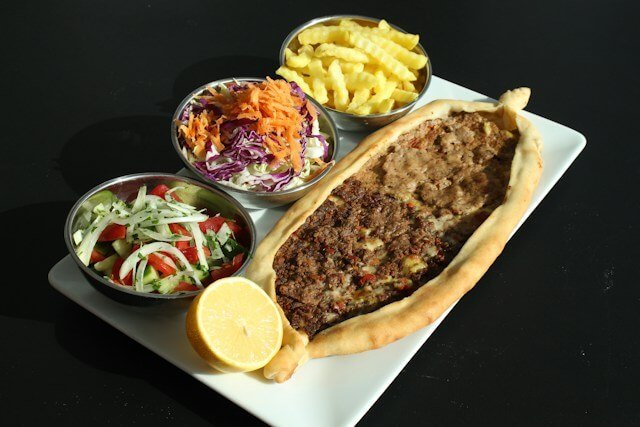
Spice Level Adjustment
While not all Lebanese cuisine is spicy, chilies are used in some recipes. The spice level can usually be adjusted to suit your client’s preference by using fewer chilies or eliminating them altogether.
However, keep in mind that some dishes may lose their traditional flavor without the heat of chilies. It’s always best to communicate with your client beforehand to ensure you’re creating a dish that fits their taste preferences.
Cultural Significance of Lebanese Cuisine
Food plays a central role in Lebanese culture and is often tied to family gatherings and celebrations. Many dishes are shared, promoting a sense of community and hospitality. Lebanese cuisine is a fusion of Mediterranean and Middle Eastern flavors, influenced by the country’s history and geography.
History and Influences
Lebanon has a rich culinary history dating back thousands of years. Its location on the crossroads of ancient trade routes brought different cultures and ingredients to its borders, resulting in a diverse cuisine. Phoenician, Roman, Ottoman, and Persian influences can be seen in traditional Lebanese dishes.
One of the defining features of Lebanese cuisine is its use of fresh, simple ingredients. The fertile land produces an abundance of fruits, vegetables, grains, herbs, and spices that are used to create flavorful dishes. Herbs like mint, parsley, thyme, and oregano are commonly used in cooking.
Mezze: Small Plates, Big Flavors
A cornerstone of Lebanese cuisine is the mezze, a selection of small dishes that are typically served before the main course. These small plates allow for a variety of flavors and textures to be enjoyed in one meal. Mezze can include dishes like hummus, baba ghanoush, falafel, tabbouleh, and stuffed grape leaves.
Grains and Vegetables Galore
Lebanese cuisine is known for its use of grains such as bulgur wheat, rice, and lentils. These staples make up the base of many dishes and are often paired with fresh vegetables like tomatoes, cucumbers, eggplant, and onions.
Meat Dishes: A Celebration of Flavor
Mezze and vegetarian options may be plentiful in Lebanese cuisine, but meat dishes are not to be overlooked. Grilled meats like kebabs and shawarma are popular choices, as well as hearty stews like kibbeh nayeh, a dish made with raw minced lamb or beef mixed with bulgur wheat and spices.
The Power of Herbs and Spices
Parsley, thyme, and oregano are commonly used herbs in Lebanese cooking, giving dishes a fragrant and flavorful kick. Other spices such as cumin, sumac, and cinnamon also play a significant role in creating the unique taste of traditional Lebanese cuisine.
Desserts: Sweet Endings
No meal is complete without something sweet to satisfy the palate. Lebanese desserts are known for their rich and indulgent flavors, often incorporating ingredients like dates, pistachios, and honey. Popular choices include baklava, a flaky pastry filled with nuts and sweet syrup, and maamoul, a cookie-like treat filled with dates or nuts.
The Importance of Fresh Ingredients
In Lebanese cuisine, the use of fresh ingredients is essential to creating authentic and delicious dishes. From locally sourced produce to high-quality meats and dairy products, every ingredient has a purpose in adding depth and flavor to each dish.
Food as a Way of Bringing People Together
Lebanese culture places great emphasis on food not just as sustenance but also as a way of connecting people. Meals are often shared family-style.
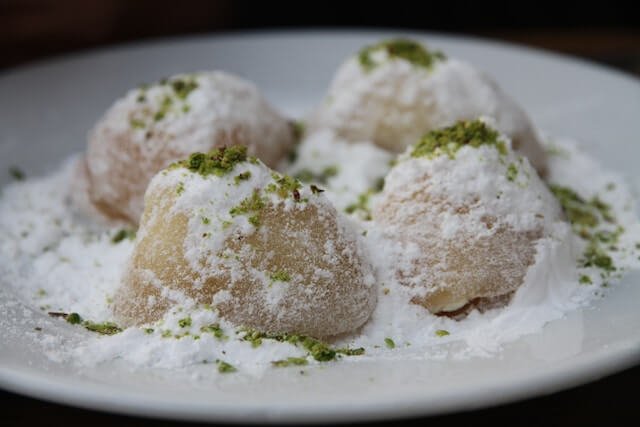
Dietary Considerations
When preparing Lebanese cuisine, it’s important to consider dietary restrictions. Many Lebanese dishes are vegetarian or vegan-friendly, and gluten-free options are also available. At The Organic Personal Chef, we understand the importance of catering to all dietary needs and creating delicious meals that our clients will enjoy.
Health Considerations
Lebanese cuisine, like many other Mediterranean cuisines, is considered healthy due to its emphasis on fresh fruits and vegetables, whole grains, and heart-healthy fats from olive oil and nuts.
However, there are some specific health considerations to keep in mind when preparing Lebanese dishes.
First and foremost, allergies should always be taken into consideration. Many traditional Lebanese dishes contain nuts or dairy products, which can be problematic for those with allergies. It is important to clearly label any potential allergens in your dishes and offer alternative options for those who cannot consume them.
Secondly, portion control is crucial when it comes to maintaining a healthy diet. Lebanese cuisine is known for its generous portions and communal style of dining, where multiple dishes are shared between family and friends. While this fosters a sense of community and connection through food, it can also lead to overeating. Encourage your clients to practice mindful eating.
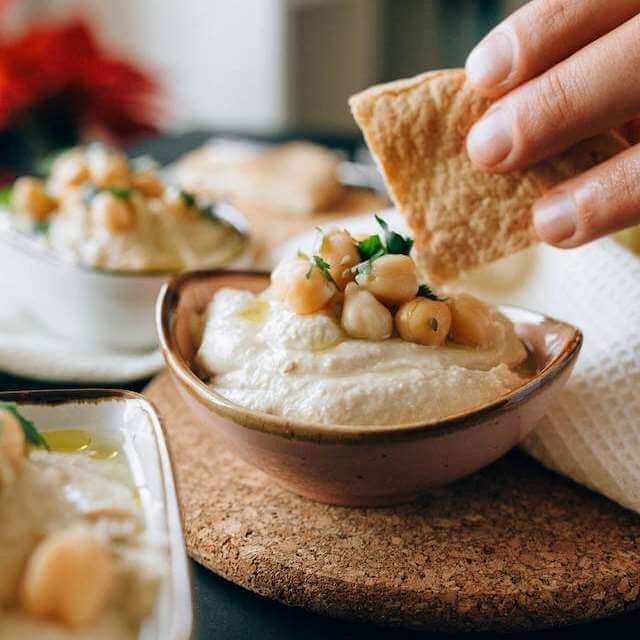
Traditional Accompaniments
Lebanese meals often start with a meze (an assortment of small dishes), followed by a main course, and end with a dessert like baklava. Freshly baked bread, like pita, is a common accompaniment. Other traditional accompaniments include yogurt, olives, pickles, and various dips such as hummus or baba ghanoush. These accompaniments not only add flavor to the meal but also help cleanse the palate between courses.
Meze
Meze is a popular part of Lebanese cuisine. It consists of an assortment of small dishes served as appetizers before the main course. Meze can vary in size and composition depending on the occasion and the number of guests.
Some common meze dishes include tabbouleh (a salad made with bulgur wheat and parsley), falafel (deep-fried chickpea balls), and kibbeh (minced meat and bulgur wheat patties). Meze allows for a communal dining experience, with everyone sharing and tasting different dishes together.
Pita Bread
No Lebanese meal is complete without pita bread. This soft and fluffy flatbread is used as a utensil to scoop up dips and other foods. Pita bread is also commonly stuffed with meat or vegetables to make sandwiches or wraps. It is typically baked in a wood-fired oven, giving it a unique and delicious flavor.
Presentation
In Lebanese cuisine, the presentation is important. Dishes are often colorfully garnished with fresh herbs, and served in communal dishes promoting the spirit of sharing. This reflects the Lebanese culture of hospitality and generosity.
At The Organic Personal Chef, we believe that presentation is just as important as taste. I would always take great care in plating each dish to not only enhance the visual appeal but also elevate the dining experience for our clients.

Common Variations
Lebanon‘s diverse regions each have their unique flavors and dishes. For example, coastal areas are known for their seafood dishes, while mountainous regions often feature more meat and cheese. However, there are some common variations of Lebanese cuisine that can be found throughout the country.
Preparation and Equipment
Some Lebanese dishes may require specific equipment, like a grill for kebabs. Certain elements of a dish, like dough for bread or marinating meats, may need to be prepared ahead of time. Be sure to read the recipe instructions carefully and have all necessary ingredients and equipment ready before you begin cooking.
Cooking Techniques
One of the defining characteristics of Lebanese cuisine is the use of cooking techniques that bring out the natural flavors of the ingredients. Grilling, roasting, and slow cooking are commonly used methods.
Grilling is a popular way to cook meats and vegetables in Lebanese cuisine. The intense heat quickly sears the outside while keeping the inside juicy and flavorful. You can also grill flatbreads, such as pita or naan, which are often served alongside meals.
Roasting is another common technique used in Lebanese cooking. Meats and vegetables are often marinated with herbs and spices before being roasted in the oven. This method allows for deep flavors to develop while creating tender and succulent dishes.
Slow cooking, also known as braising, involves cooking ingredients at a low temperature for an extended period of time. This method is perfect for tough cuts of meat, as it allows them to become tender and infused with the flavors of the ingredients they are cooked with.
The use of these cooking methods can be seen in many traditional Lebanese dishes. For example, shish taouk, a popular grilled chicken dish, is often served with grilled vegetables and a side of roasted potatoes. Another classic dish, kibbeh bil sanieh, involves layering seasoned ground beef with bulgur wheat and slow roasting it in the oven.
There are also many vegetarian options that highlight these cooking techniques. Grilled halloumi cheese is a tasty addition to any meal, while roasted eggplant makes for a rich and satisfying appetizer or side dish.
Essential for preparing stews and soups, which are staples in Lebanese cuisine.
Used to make traditional flatbreads like manakish.
Used for grinding spices and herbs, common in Lebanese dishes.
Small plates used for serving a variety of appetizers.
Necessary for sautéing and pan-frying ingredients.
Although originally Moroccan, this cone-shaped pot is also used in Lebanese cooking for slow-cooking dishes to enhance their flavor.
A good quality, sharp chef’s knife is necessary for precise cutting and slicing of ingredients.
A sturdy cutting board is needed for preparing ingredients.
Various sizes are useful for preparing and mixing ingredients.
For roasting vegetables and baking pastries.
Frequently used in Lebanese cooking for extracting juice from lemons.
Useful for separating solids from liquids when making broths or sauces.
Essential for serving soups and stews.
Handy for turning and handling food, especially when frying or grilling.
For accurate measurement of ingredients.
Remember, investing in high-quality tools can greatly enhance your cooking experience and the outcome of your dishes. Keep them well-maintained for the best results.
Wondering what tools a personal chef might need? I’ve written an extensive article for you – A Comprehensive List Of Must-Have Tools and Essential Items for the Personal Chef
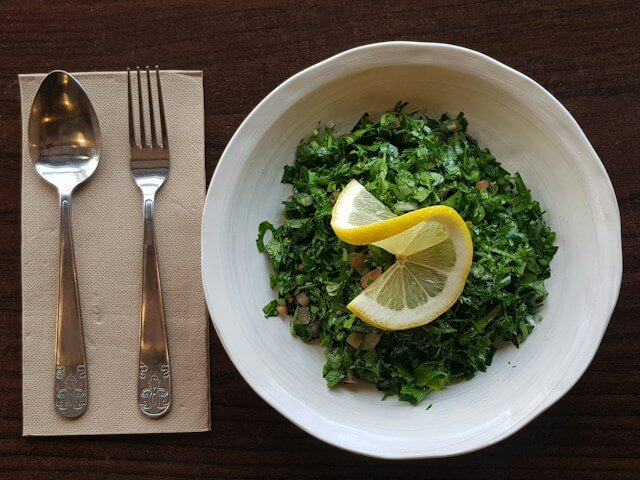
Personalizing Lebanese Cuisine
Personalizing Lebanese dishes while maintaining authenticity can be achieved by adjusting flavors to suit personal preferences, substituting ingredients based on dietary needs, or presenting dishes in creative ways. Lebanese cuisine is known for its rich history and diverse flavors, making it a favorite among food enthusiasts. With its Mediterranean influence, Lebanese dishes are typically characterized by their freshness and use of herbs and spices.
One way to personalize Lebanese cuisine is by adjusting the flavors according to personal preferences. For example, if you prefer your food to be spicier, you can add more chili flakes or cayenne pepper to your dish. If your clients have a sweet tooth, you can incorporate more honey or dried fruits in their dishes. The beauty of Lebanese cuisine lies in its flexibility and ability to cater to different taste buds.
Another way to personalize Lebanese dishes is by substituting ingredients based on dietary needs. With the rise of plant-based diets, many traditional Lebanese recipes have been adapted to include vegan or vegetarian options. For instance, instead of using meat in a traditional kibbeh (a popular Lebanese dish made with minced meat and bulgur wheat), you can use lentils or mushrooms for a delicious plant-based version.
In addition to being adaptable, Lebanese cuisine is also known for its health benefits. The Mediterranean diet, which is heavily influenced by Lebanese cuisine, has been praised by health experts for its high consumption of fresh fruits and vegetables, whole grains, and healthy fats like olive oil. By incorporating more Lebanese dishes into your client’s meal rotation, they can reap the nutritional benefits while still enjoying flavorful and satisfying meals.
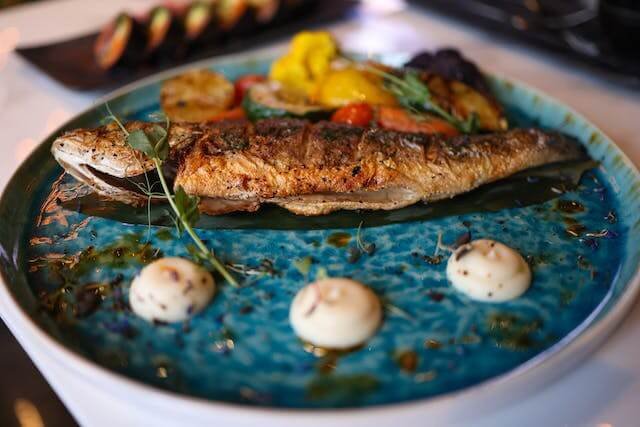
Lebanese Food for Personal Chefs
Exploring and cooking Lebanese cuisine offers a rewarding culinary journey. By understanding its key ingredients, techniques, and cultural significance, we can bring the authentic taste of Lebanon to our clients’ dining tables.
Here are some of my favorite tools for providing my personal chef service
As an experienced personal chef, I’ve found that the secret to creating mouthwatering dishes goes beyond just having a passion for food. It’s also about using the right kitchen tools. Today, I’m going to share with you my must-have kitchen items that help me bring my culinary creations to life.
1. Chef’s Knife
The first item on my list is a high-quality chef’s knife. It’s the most versatile tool in my kitchen, perfect for chopping, slicing, and dicing. My preference is for a Global Chef’s Knife, known for the edge and the way they are balanced.
2. Cast Iron Skillet
Next up is a good old cast-iron skillet. From searing steaks to baking cornbread, this pan does it all. I love the Lodge Cast Iron Skillet, which retains heat beautifully and adds a nice crust to anything you cook.
3. Stainless Steel Pots and Pans
A set of stainless steel pots and pans is essential for a variety of cooking techniques. They’re great for simmering, boiling, and sautéing. All-Clad’s Stainless Steel Cookware Set is my go-to choice for its exceptional performance and durability.
4. Immersion Blender
An immersion blender makes pureeing soups, making smoothies, and blending sauces a breeze. I suggest the Braun Multiquick Hand Blender, which is powerful, easy-to-clean, and highly versatile.
5. Digital Thermometer
To ensure perfectly cooked meats every time, a digital thermometer is a must. The ThermoPro TP19 Waterproof Digital Meat Thermometer provides speedy and accurate readings, ensuring your roast chicken or prime rib is cooked to perfection.
6. Silicone Spatula
A silicone spatula is a chef’s best friend for its versatility. It’s heat-resistant, non-stick, and perfect for everything from folding batter to stirring sauces. I recommend the OXO Good Grips Silicone Spatula.
7. Stand Mixer
Lastly, for avid bakers, a stand mixer is a game-changer. The KitchenAid Artisan Series 5-Qt. Stand Mixer isn’t just a pretty face; it makes mixing doughs and batters effortless.
These are the tools that I use daily in my personal chef service. Remember, quality tools make a difference, but they don’t have to break the bank. Start with the basics and add on as you grow more comfortable and adventurous in the kitchen.
Happy cooking!

